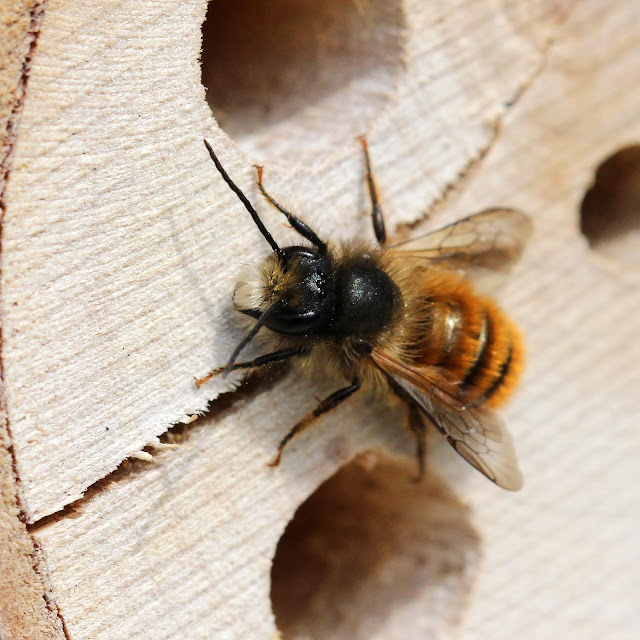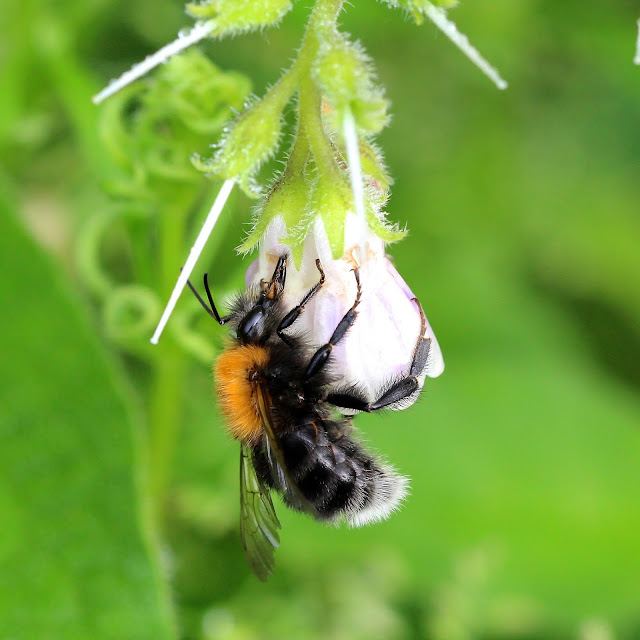I recently had the opportunity to try two Acorn trail cameras and compare them with my Bushnell NatureView HD Cam. The Bushnell works reasonably well in daylight with both stills and video but the infrared stills are disappointing and the infrared video is only just OK.
The Acorn 5210A is a basic model and the video seemed to have fault that I couldn't overcome with the menu settings or the manual - despite being set to record for 30s it cut out every time after less than a second giving only tantalising glimpses of the fox. The infrared stills were OK.
The early morning colour shot was very grainy but technically challenging because of the dark foreground and very bright light in the background.
The Acorn 6210MC is a more advanced camera and worked as set in still and video mode. I tried it in the garden and in darkness the infrared still shot was like this - only good enough for a record shot.
When the security light came on the camera worked in colour - not too bad.
The video results were variable, again better with more light but disappointing in total darkness. In this clip the fox and hedgehog are sharing dinner and the foreground is overexposed. The hedgehog runs out of frame and triggers the security light. The camera takes a second or two to adjust but you can see the improvement in resolution.
This next clip was shot in twilight with extra light from a 60W wall light but the camera is in infrared mode. The two hedgehogs are joined by the younger fox. The resolution here is OK.
In this last clip the security light is on. The camera starts in colour mode but clicks almost instantly to B&W (it did this every time and again I can't find out why in the menu settings or the manual). The resolution is notably better with more light.
If they are in the same video format as the Bushnell these clips won't play in Safari on an iPad but I can't test it before publishing the post.
Overall I don't think these cameras are significantly better than the Bushnell, which also does better in B&W with more illumination from the security light. I am still looking out for a better trail camera. If you know of one to recommend please leave a comment.
It was only eight weeks ago that I saw my first male red mason bee but their season is now over. All the adults have died, leaving their eggs hatching into larvae, eventually to provide the next generation next year.
These are early season males on the look out for females.
Later on the males had lost most of their colour and looked like this.
Here is one of the first females resting in a hole in the bee house. There is a good view of the two horns on her face used for manipulating the mud (hence Osmia bicornis).
This one is looking out of the entrance, about to collect more pollen.
Two bees started building in the observation wing. The top bee disappeared before finishing her second cell - she was probably eaten by a bird or spider.
Here is the lower bee either unloading pollen or laying an egg.
Here she is returning with a load of mud for the next cell wall.
She eventually filled 11 cells and then sealed the entrance, leaving the front cell empty.
A few days later I noticed the cell had been attacked and the front two cells raided, probably by a woodpecker.
Here is another bee just finishing the seal to her nest.
We are just starting the leaf cutter bee season here - expect a report on the blog in the near future.
This is an elusive bird, often heard yaffling but rarely seen. Even then it is usually peeping from the far side of a tree trunk or branch. So it was a rare and wonderful opportunity to watch and photograph this female green woodpecker. Many many thanks to Denise & Phil.
The European green woodpecker (Picus viridis) is our largest woodpecker. Although it nests in a hole in a tree it spends a lot of time on the ground hunting for ants and has a long sticky tongue for collecting them.
Green woodpecker numbers are increasing
but it is less common here in the north of the country.
In Thomas Bewick's time the green woodpecker was only the second largest British woodpecker (he records the black woodpecker as a resident bird!). This is the male green woodpecker from his 1797 A History of British Birds.
Bewick gives the bird's other names of Woodspite, High-Hoe, Hew-Hole and Pick-a-Tree. He writes "... it is called by the common people ... Rain-Fowl, from its being more loud and noisy before rain. The old Romans called it Pluviae aves for the same reason.". He also made a watercolour.
You can read more about the green woodpecker here. Listen to a recording of the yaffle here. And listen to Kate Humble's BBC Radio 4 Tweet of the Day on green woodpecker here.
This is the red-headed cardinal beetle (Pyrochroa serraticornis). It eats flying insects but catches them on flowers and leaves. This one was warming up in the sun in the early morning. It is distinguished from the scarlet lily beetle by its toothed antennae, red head and non-dimpled wing cases.
This year's young woodpeckers arrived in the garden at the end of last week but I have been frustrated in my attempts at photographing them being fed. Until this morning, that is, when I finally got lucky.
When they first arrive the chicks sit high in the trees waiting for their parents to bring them food, calling but out of view. Then when they move closer they are usually just out of view, or behind a branch, or on the wrong side of a tree trunk, or it is raining and the window is closed! There are usually only two or three days before the youngsters can get onto the feeders and after that the parents leave them to it.
It is just over two years since I started this blog. My very first post was on great spotted woodpeckers feeding their young. Since then there have been over 400 posts and over 40,000 page views but this remains one of my favourite photographic subjects. It is interesting that I managed the first photo on 14th June in 2014 and 18th June 2015 so it is perhaps a measure of the lateness of the season after a long cold spring this year.
If you are a short-tongued bumblebee faced with a long flower you have a problem. You can't reach the nectaries which are cunningly placed at the base of the flower to make you squeeze past the anthers and stigma(s). Unless, of course, you cheat. Comfrey is a very enticing flower but its sweet nectar is out of reach of bees such as this male early bumblebee (Bombus pratorum). His solution is to use a hole bitten in the side of the flower to steal the nectar without helping with pollination.
If you look carefully you will see that on some comfrey plants every flower has a tiny hole bitten in the side.
Other short-tongued bees that rob nectar include the tree bumblebee (Bombus hypnorum)
and the common carder bee (Bombus pascuorum).
Worker bumblebees vary in side and the smaller ones can get right inside using the correct entrance, like this common carder bee. It is interesting that there were no holes in the flowers on this plant.
Long-tongued bees like the garden bumblebee (Bombus hortorum) don't have a problem.
Surprisingly the robbing doesn't seem to have much effect on a plant's reproductive success. You can read more about the biology of nectar robbing here.




















































